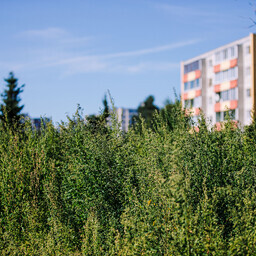Botaanik Toomas Kukk ütleb, et kõik
avalikud haljasalad
ei pea olema
niitmata heinamaa
d. Mõnes kohas võiks niita tihti, teistes piirduda ühe-kahe niitega aastas.
avalikud haljasalad
Tõlge fraasile: avalikud haljasalad
EN
public green areas
niitmata heinamaa
Tõlge fraasile: niitmata heinamaa
EN
unmown meadow
Kukk räägib, et
liikide tagasi tulek
võtab aega. Ta räägib oma sõbrast, kes niidab oma aias vähem. Sügisel niidab ta kogu aia. Nüüd on tal aias orhideed, kuid selleks kulus umbes 15 aastat.
liikide tagasi tulek
Tõlge fraasile: liikide tagasi tulek
EN
return of species
Kukk soovitab, et koduaias võiks niita ühel aastal rohkem ühest kohast ja teisel aastal teisest kohast. Ta ütleb, et vaja on
rohkem mitmekesisust niitmises
.
rohkem mitmekesisust niitmises
Tõlge fraasile: rohkem mitmekesisust niitmises
EN
more diversity in mowing
Ta soovitab ka seemnesegude külvamist. Turul on erinevaid seemnesegusid, mis sobivad erinevatesse kohtadesse. See aitab muuta muruplatsi mitmekesisemaks.
Tartu Ülikooli professor Martin Zobel ütleb, et
elurikkus
tekib seal, kus on vastavad liigid. Linna haljasalal
elurikkus
t eriti pole. Niitmata jätmine toob kaasa pikkade kõrreliste kasvu.
elurikkus
Tõlge fraasile: elurikkus
EN
biodiversity
elurikkus
Tõlge fraasile: elurikkus
EN
biodiversity
Zobel soovitab külvata seemnesegusid. Ta ütleb, et
linnamuld
on tavaliselt viljakas, mis toetab kõrreliste kasvu. Ta räägib, et mulla viljakust tuleks vähendada.
linnamuld
Tõlge fraasile: linnamuld
EN
urban soil
Zobel ütleb, et
elurikkus
t saab toetada ka koduaias. Ta räägib oma abikaasast, kes on teinud murust
lillerikka aasa
. Ta soovitab niita siis, kui seemned on valmis.
elurikkus
Tõlge fraasile: elurikkus
EN
biodiversity
lillerikka aasa
Tõlge fraasile: lillerikka aasa
EN
flower-rich meadow
Zobel jagab nippe, kuidas muuta koduaias
elurikkus
t. Ta räägib, et mõned
tugevamad liigid
võivad võimust võtta. Tema koduaias on selliseks liigiks võilill.
elurikkus
Tõlge fraasile: elurikkus
EN
biodiversity
tugevamad liigid
Tõlge fraasile: tugevamad liigid
EN
stronger species
Zobel soovitab koduaias kasutada näiteks harilikku härjasilma ja
nurmenukk
u. Mõlemad lilled on koduaias elujõulised. Ta ütleb, et seemnesegud aitavad aeda elavdada.
nurmenukk
Tõlge fraasile: nurmenukk
EN
forget-me-not
Botanist Toomas Kukk says that not all public green spaces need to be unmown meadows. In some places, frequent mowing may be necessary, while in others, one or two mows per year may suffice.
Kukk mentions that the return of species takes time. He talks about his friend who mows his garden less often. In autumn, he mows the entire garden. Now he has orchids in his garden, but it took about 15 years.
Kukk suggests that in a home garden, one could mow more from one area one year and from another area the next year. He says there is a need for more diversity in mowing.
He also recommends sowing seed mixes. There are various seed mixes available on the market that are suitable for different locations. This helps make the lawn more diverse.
Professor Martin Zobel from the University of Tartu says that biodiversity arises where there are appropriate species. In city green spaces, there is little biodiversity. Leaving areas unmown leads to the growth of tall grasses.
Zobel recommends sowing seed mixes. He says that urban soil is usually fertile, which supports the growth of grasses. He mentions that the fertility of the soil should be reduced.
Zobel says that biodiversity can also be supported in a home garden. He talks about his spouse, who has created a flower-rich patch in the lawn. He advises mowing when the seeds are ready.
Zobel shares tips on how to increase biodiversity in a home garden. He mentions that some stronger species may dominate. In his garden, dandelion is such a species.
Zobel recommends using, for example, common eyebright and meadow buttercup in the home garden. Both flowers are vibrant in the garden. He says that seed mixes help enliven the garden.

